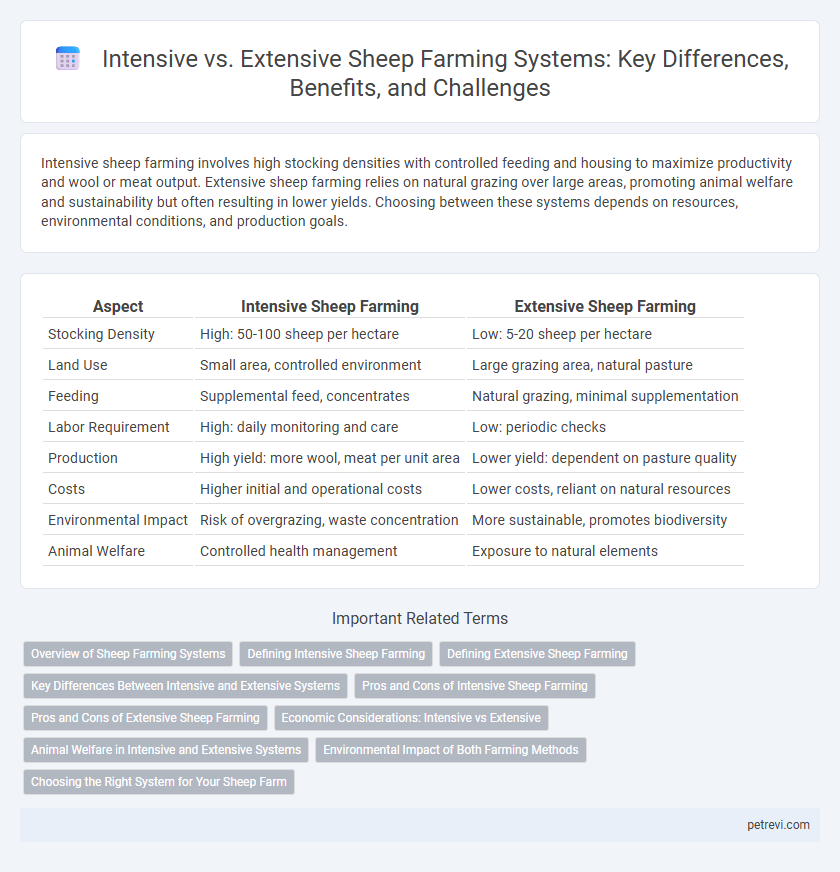Intensive sheep farming involves high stocking densities with controlled feeding and housing to maximize productivity and wool or meat output. Extensive sheep farming relies on natural grazing over large areas, promoting animal welfare and sustainability but often resulting in lower yields. Choosing between these systems depends on resources, environmental conditions, and production goals.
Table of Comparison
| Aspect | Intensive Sheep Farming | Extensive Sheep Farming |
|---|---|---|
| Stocking Density | High: 50-100 sheep per hectare | Low: 5-20 sheep per hectare |
| Land Use | Small area, controlled environment | Large grazing area, natural pasture |
| Feeding | Supplemental feed, concentrates | Natural grazing, minimal supplementation |
| Labor Requirement | High: daily monitoring and care | Low: periodic checks |
| Production | High yield: more wool, meat per unit area | Lower yield: dependent on pasture quality |
| Costs | Higher initial and operational costs | Lower costs, reliant on natural resources |
| Environmental Impact | Risk of overgrazing, waste concentration | More sustainable, promotes biodiversity |
| Animal Welfare | Controlled health management | Exposure to natural elements |
Overview of Sheep Farming Systems
Intensive sheep farming systems prioritize high stocking densities and controlled feeding regimes to maximize productivity and wool or meat yield on limited land areas. Extensive sheep farming relies on natural pastures, lower stocking rates, and minimal human intervention, supporting sustainable grazing over large, often marginal lands. These systems differ significantly in resource input, animal management, and environmental impact, aligning with specific economic goals and regional conditions.
Defining Intensive Sheep Farming
Intensive sheep farming is characterized by high stocking densities and controlled environments designed to maximize production efficiency and wool or meat yield per unit area. This system relies heavily on supplemental feeding, health management, and shelter to optimize growth rates and reproductive performance. Intensive methods contrast with extensive systems, which depend on natural grazing and lower input levels over larger land areas.
Defining Extensive Sheep Farming
Extensive sheep farming involves raising sheep over large areas with low stocking density, relying mainly on natural pastures for grazing. This system minimizes input costs by using native vegetation and requires less management and infrastructure compared to intensive farming. Extensive farming is suitable for regions with vast land availability and aims to maximize natural resource use while maintaining sustainability.
Key Differences Between Intensive and Extensive Systems
Intensive sheep farming involves high stocking densities, controlled feeding regimes, and significant labor inputs to maximize wool and meat production on smaller land areas. Extensive systems use larger grazing lands with lower stock densities, relying on natural forage and minimal supplementary feeding, resulting in lower costs but slower production rates. Key differences include land use efficiency, input intensity, and production output, with intensive systems emphasizing productivity and extensive systems focusing on sustainability and low environmental impact.
Pros and Cons of Intensive Sheep Farming
Intensive sheep farming maximizes productivity by using high stocking densities, controlled feeding, and advanced breeding techniques, leading to faster growth rates and higher wool or meat output. However, this system often involves higher operational costs, increased risk of disease transmission, and potential animal welfare concerns due to limited grazing and confinement. Despite these drawbacks, intensive farming can ensure consistent product quality and year-round production, making it suitable for regions with limited land resources.
Pros and Cons of Extensive Sheep Farming
Extensive sheep farming involves raising sheep on large, natural grazing areas with minimal human intervention, which reduces feed costs and supports animal welfare by allowing natural behaviors. This system benefits from lower infrastructure and labor expenses, but it may result in slower growth rates, higher vulnerability to predators, and less controlled breeding conditions. Extensive farming is more sustainable in terms of land use but faces challenges in managing disease and ensuring consistent wool or meat quality.
Economic Considerations: Intensive vs Extensive
Intensive sheep farming maximizes economic returns through higher stocking densities and controlled feeding, leading to increased production per hectare but higher input costs such as feed, labor, and infrastructure. Extensive systems rely on natural grazing with lower input expenses, reducing operational costs but resulting in lower productivity and income per unit area. Economic viability depends on market prices, land availability, and resource management, with intensive systems favoring short-term profits and extensive systems supporting sustainability and lower financial risk.
Animal Welfare in Intensive and Extensive Systems
Intensive sheep farming systems concentrate animals in confined spaces to maximize production, often leading to stress, limited natural behaviors, and increased disease risk, which can adversely affect animal welfare. Extensive systems allow sheep to graze over larger areas, promoting natural behaviors, better mental health, and lower disease incidence, but may expose animals to environmental hazards and predators. Balancing these systems requires careful management to optimize both productivity and the physical and psychological well-being of sheep.
Environmental Impact of Both Farming Methods
Intensive sheep farming typically results in higher greenhouse gas emissions, soil degradation, and water pollution due to concentrated animal waste and feed production inputs. Extensive sheep farming generally has a lower environmental footprint by promoting grazing on natural pastures, enhancing biodiversity and reducing reliance on chemical fertilizers and pesticides. However, overgrazing in extensive systems can lead to soil erosion and habitat loss if not managed sustainably.
Choosing the Right System for Your Sheep Farm
Intensive sheep farming maximizes productivity on limited land by providing controlled feeding, shelter, and health management, ideal for regions with high land costs or limited pasture. Extensive systems rely on natural grazing over larger areas, reducing feed costs and promoting animal welfare, suitable for farms with ample pasture and lower labor input. Selecting the right system depends on land availability, resource allocation, and production goals to optimize sheep growth and profitability.
Intensive vs Extensive for Sheep Farming System Infographic

 petrevi.com
petrevi.com